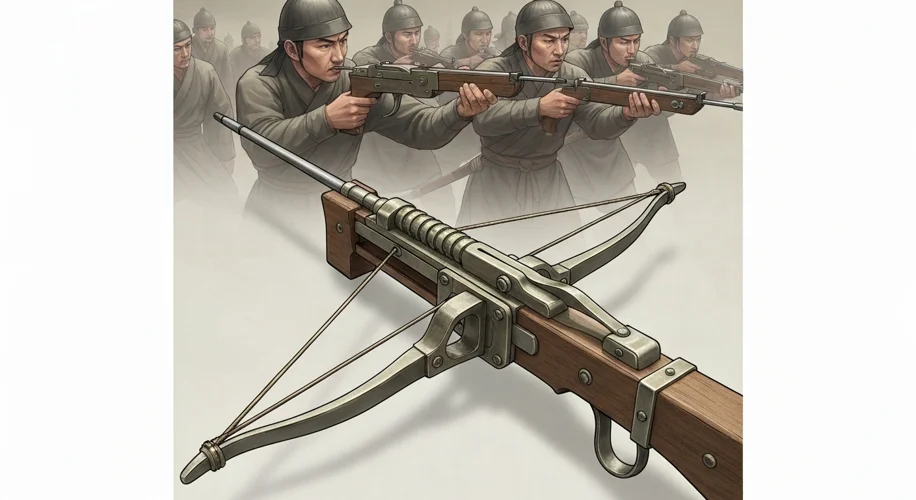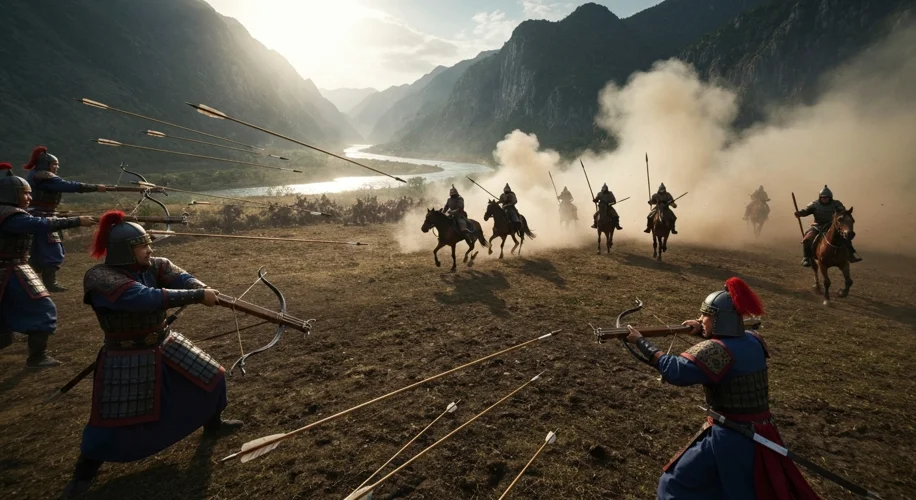Imagine a battlefield in the heart of China, two millennia ago. Soldiers aren’t just hurling arrows one by one; they’re unleashing a volley, a hail of death, from a single, terrifying device. This wasn’t a fantasy; it was the reality of the Chinese repeating crossbow, a marvel of engineering that predates its Western counterparts by centuries.
For ordinary folks interested in history, the story of the repeating crossbow is a tantalizing glimpse into how technological divergence can shape the course of empires. While the Roman Empire was building roads and legions, and Europe was still emerging from the shadow of the Dark Ages, China was perfecting a weapon that could fire multiple bolts from a single cocking action, thanks to an ingenious repeating mechanism. This wasn’t a mere innovation; it was a quantum leap.

The earliest evidence of this sophisticated weapon points to the Warring States period (475-221 BCE), with its technology reaching a peak during the Han Dynasty (206 BCE – 220 CE). This was precisely the era when the Roman Empire, Rome’s equivalent of advanced military might, was dominating the Mediterranean. Yet, no such auto-crossbow technology emerged in the West. Why this stark contrast? The answer lies not just in engineering prowess, but in the very fabric of their societies, their military doctrines, and their cultural outlooks.
A Tale of Two Worlds
China, during these periods, was a land of centralized empires, where grand infrastructure projects, including sophisticated weaponry, were feasible and encouraged. The Han Dynasty, in particular, faced constant threats from nomadic peoples to its north, like the Xiongnu. A weapon that could deliver sustained, rapid fire would have been invaluable in repelling cavalry charges. The repeating crossbow, with its ability to lay down a devastating barrage, fit this need perfectly.
Its mechanism, often involving a sliding bolt magazine and a lever or slide for reloading and re-cocking, was a testament to Chinese mechanical genius. Unlike the simple, single-shot crossbows prevalent in Europe, the Chinese version was a force multiplier, capable of turning a well-trained crew into a veritable hail of arrows. Imagine the psychological impact of facing a weapon that could seemingly shoot without pause, its bolts whistling through the air in quick succession.
Meanwhile, in the West, the military landscape was vastly different. The Roman army relied on disciplined infantry formations, siege engines, and the formidable pilum (a javelin) and gladius (a short sword). While they did employ archers and crossbowmen, their technology remained relatively static for centuries. The crossbow, when it did arrive in Europe, was a heavy, single-shot weapon, often requiring significant strength and time to reload.
The Missing Link: Why the West Lagged
Several factors likely contributed to the West’s slow adoption or lack of development in auto-crossbow technology:
- Military Doctrine: Roman and later European warfare often emphasized shock tactics, close-quarters combat, and individual prowess. The idea of a rapid-fire weapon might not have aligned with their tactical approaches. The repeating crossbow demanded a different kind of battlefield control, one focused on sustained suppression rather than decisive charges.
- Societal Structure: While China had a strong tradition of state-sponsored innovation and large-scale production, Western societies, particularly during the early medieval period, were more decentralized. The resources and centralized authority needed to develop and disseminate such a complex weapon might have been lacking.
- Craftsmanship and Material: The intricate mechanisms of the Chinese repeating crossbow required a high level of metallurgical skill and precision craftsmanship. While European smiths were skilled, the specific demands of this complex design might have been beyond their immediate capabilities or the available materials.
- **

